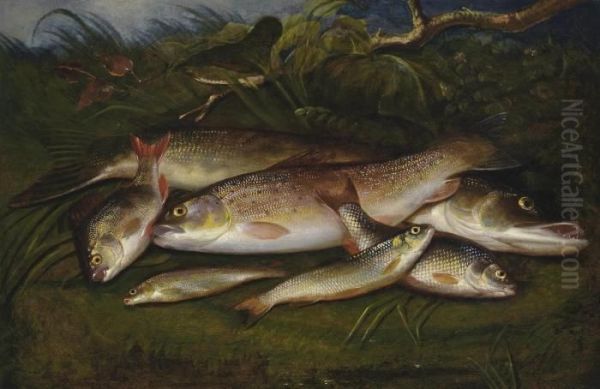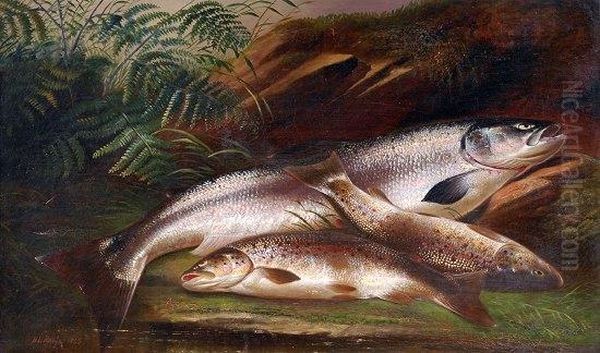Henry Leonidas Rolfe stands as a notable, if somewhat specialized, figure within the bustling art world of Victorian Britain. Active primarily between 1847 and 1881, he carved a distinct niche for himself as a painter of fish and angling scenes, a passion that clearly resonated through his canvases and garnered him considerable recognition during his lifetime. His dedication to this subject matter, combined with a keen eye for detail and a profound understanding of his subjects, allowed him to produce works that were both aesthetically pleasing and remarkably true to life.
Biographical Sketch and Artistic Milieu
Born in London, likely around 1823, Henry Leonidas Rolfe's early life details remain somewhat elusive, a common occurrence for artists who did not achieve the stratospheric fame of some of their contemporaries. Sources suggest his birthplace was Holliwell, near London, or perhaps Holloway in North London. He is known to have resided and worked in various parts of London, including Hammersmith, throughout his career. He passed away in 1881, leaving behind a legacy of works cherished by anglers and art collectors alike.
Rolfe's artistic journey unfolded during a period of immense change and dynamism in British art. The Royal Academy of Arts, founded in 1768, was the dominant institution, setting tastes and providing a crucial platform for artists to exhibit and gain patronage. The Victorian era saw a burgeoning middle class with disposable income and an interest in acquiring art, leading to a diverse market that could support artists with specialized interests, such as Rolfe's focus on ichthyological subjects.
The Angler's Eye: Subject Matter and Specialization
Rolfe was, by all accounts, an enthusiastic angler himself. This personal passion is a critical element in understanding his art. It wasn't merely a detached observation of fish as still life objects; it was an intimate familiarity with their forms, textures, colours, and the environments they inhabited. His paintings often depict "a day's catch," showcasing a variety of freshwater or saltwater fish, sometimes alongside the tools of the angler's trade – rods, reels, creels, and nets.

His specialization was primarily in oil painting, but he was also known to create plaster casts of fish. This practice of casting, often associated with scientific study or taxidermy, underscores his commitment to accuracy and his deep knowledge of piscine anatomy. These casts would have served as excellent three-dimensional references, allowing him to study the play of light and shadow on scales and fins in his studio, supplementing his observations from life.
The still life genre, particularly involving game or the bounty of the hunt (or catch), had a long and distinguished history in European art, reaching a zenith with Dutch Golden Age painters. Rolfe’s work can be seen as a continuation and a very British interpretation of this tradition.
Artistic Style and Technique
Henry Leonidas Rolfe’s style is characterized by a meticulous realism. He rendered the iridescent scales of salmon, the mottled skin of pike, and the silvery sheen of trout with remarkable precision. His ability to capture the subtle variations in colour and texture, the glistening wetness of a freshly caught fish, or the stillness of death without sacrificing the inherent beauty of the creature, was a hallmark of his work.
His compositions are typically well-balanced, often arranging the fish in a naturalistic tumble on a riverbank, in a creel, or laid out for admiration. The backgrounds, though sometimes simple, often suggest the locale of the catch – a mossy bank, a glimpse of water, or reeds. This contextualization adds to the narrative of the angler's success and the natural beauty of the British countryside or coastline.
While not an innovator in the avant-garde sense, Rolfe’s technical proficiency within his chosen genre was considerable. He understood how to use light to define form and create a sense of depth and tactility. His brushwork, while detailed, often retained a certain painterly quality that prevented his works from becoming mere slavish copies of nature, imbuing them instead with an artistic vitality.
Notable Works and Their Characteristics
Several titles of Rolfe's paintings give a clear indication of his thematic concerns. Works such as "A day's catch on a riverbank" (1877) exemplify his classic approach. One can imagine such a canvas depicting a proud collection of fish – perhaps salmon, trout, or grayling – artfully arranged, their colours vibrant against the more muted tones of the earth and foliage. The dimensions cited for one such piece, 40.6 x 61.1 cm, suggest a scale suitable for private collection and domestic display.

Another work, "A sea bass, cat fish and lobsters," indicates his range extended to marine life. The inclusion of lobsters would have allowed for a different textural and chromatic challenge – the hard, segmented shell of the crustacean contrasting with the softer forms of the fish. A painting with this title, measuring 72 x 60 cm, suggests a more substantial piece.
The title "Trout, Pike, Roach, Dace and Gudgeon on a Riverbank" further illustrates his comprehensive knowledge of British freshwater species. Each fish would have been rendered with individual attention to its specific characteristics, appealing directly to the knowledgeable angler who could identify each species and appreciate the accuracy of its depiction.
A painting titled "Riverbank with a Catch of Fish," which reportedly sold for a significant sum (£4,683 at auction), underscores the market appeal of his work. Such prices reflect both the aesthetic quality and the specialized interest his paintings commanded. These works are more than just depictions of dead fish; they are trophies, celebrations of the angler's skill and the richness of nature.
Exhibitions and Recognition
Rolfe was a consistent exhibitor at some of the most prestigious venues in the United Kingdom, a testament to the quality of his work and its acceptance within the established art world. He showed his paintings at the Royal Academy of Arts in London, the pinnacle of artistic aspiration for many British artists. The Royal Academy's Summer Exhibition was, and remains, a major event in the cultural calendar, and inclusion was a significant mark of professional standing.
He also exhibited at the British Institution, another important London venue that held exhibitions from 1806 to 1867, offering an alternative to the Royal Academy. His work was seen at the Royal Society of British Artists (RBA), located then on Suffolk Street. The RBA provided a platform for artists who might not always align with the academic strictures of the RA.
Furthermore, Rolfe's reach extended beyond London. He exhibited with the Royal Glasgow Institute of the Fine Arts in Scotland and the Royal Hibernian Academy in Dublin, Ireland. This broad geographical spread of exhibitions indicates a national reputation and a demand for his particular brand of sporting art. The fact that his works are now held in public collections such as the Haworth Art Gallery in Accrington and the Fishmongers' Company in London further solidifies his status. The Fishmongers' Company, one of the Great Twelve Livery Companies of the City of London, has a long association with fishing, making his work a natural fit for their collection.
Rolfe in the Context of Still Life and Animal Painting
To fully appreciate Henry Leonidas Rolfe's contribution, it is useful to place him within the broader traditions of still life and animal painting. The meticulous depiction of objects, particularly food and game, has a rich lineage. The Dutch Golden Age of the 17th century saw an explosion of still life painting, with artists like Willem Claesz. Heda and Pieter Claesz creating "breakfast pieces" (ontbijtjes) of astonishing realism. More specifically relevant to Rolfe are Dutch artists like Abraham van Beijeren, who frequently painted lavish still lifes featuring fish, capturing their silvery scales and varied forms with virtuosity. Jan Weenix and Melchior d'Hondecoeter specialized in dead game and birds, demonstrating a similar focus on naturalistic detail.
In Britain, the tradition of animal and sporting painting was also strong. George Stubbs, though earlier, set a high standard for anatomical accuracy in his depictions of horses. In Rolfe's own century, Sir Edwin Landseer was a dominant figure, famed for his sentimental and dramatic paintings of animals, particularly dogs like the Newfoundland, and stags. While Landseer's approach was often more narrative and anthropomorphic, the shared emphasis on careful observation of animal subjects provides a point of comparison.
Other contemporaries who specialized in sporting or animal art include Abraham Cooper, known for his battle scenes and depictions of horses and dogs, and John Frederick Herring Sr., who was renowned for his paintings of racehorses and rural scenes. Within still life, British artists like William Henry Hunt were celebrated for their highly detailed watercolours of fruit, flowers, and birds' nests, demonstrating a similar Victorian fascination with the minutiae of the natural world. George Lance was another prominent Victorian still life painter, known for his elaborate fruit pieces. Rolfe’s focus on fish was a more specialized niche within these broader categories, but it shared their commitment to verisimilitude and often, a celebration of British nature and country pursuits.
Scientific Illustration and the Victorian Interest in Nature
Rolfe's work also touches upon the Victorian era's burgeoning interest in natural science and classification. His detailed and accurate renderings of fish verge on scientific illustration. The 19th century was a period of great exploration and scientific discovery, with figures like Charles Darwin revolutionizing biology. There was a widespread public fascination with the natural world, reflected in the popularity of natural history collections, botanical gardens, and illustrated books on flora and fauna.
Artists like John James Audubon (though primarily working in America) with his "Birds of America," or the botanical illustrations of artists like Walter Hood Fitch, demonstrate the intersection of art and science. While Rolfe's primary intent was likely aesthetic and commemorative for the angler, his precision aligns with this broader cultural current. His paintings could serve not only as pleasing pictures but also as accurate records of different fish species, appreciated for their fidelity by naturalists as well as sportsmen. His consideration as a "prominent figure in scientific illustration" by some sources highlights this aspect of his output.
The Legacy of Henry Leonidas Rolfe
Henry Leonidas Rolfe may not be a household name in the same way as some of his more famous Victorian contemporaries like John Everett Millais, Dante Gabriel Rossetti, or William Powell Frith, who tackled grander historical, literary, or social themes. However, within his specialized field, he was an acknowledged master. His paintings catered to a specific but enthusiastic audience of anglers and those who appreciated the traditions of sporting art and still life.
His legacy lies in the body of work that so vividly captures the beauty and variety of fish and the quiet satisfaction of the angler's pursuit. His paintings evoke a sense of a particular time and place – Victorian Britain, with its deep-rooted traditions of country sports and its appreciation for the natural bounty of its rivers and seas. The continued presence of his works in public and private collections, and their performance at auction, indicates an enduring appeal.
For art historians, Rolfe's work offers insight into a specific subgenre of Victorian painting, one that reflects both artistic tradition and the cultural pastimes of the era. He demonstrates how an artist can achieve distinction by dedicating their skills to a focused subject matter, executed with passion and precision. His paintings are more than just records; they are imbued with an understanding and affection for the creatures he depicted, transforming the "catch of the day" into lasting works of art.
The art world of the 19th century was vast and varied, encompassing grand history paintings, intimate genre scenes, evocative landscapes by artists like John Constable and J.M.W. Turner (though their main impact was earlier, their influence persisted), and the revolutionary aesthetics of the Pre-Raphaelite Brotherhood. Rolfe’s contribution was quieter but no less sincere, offering a window into a world where art and nature, sport and observation, converged with pleasing harmony. His dedication to his craft ensured that the fleeting beauty of a freshly caught fish could be preserved and appreciated for generations to come.